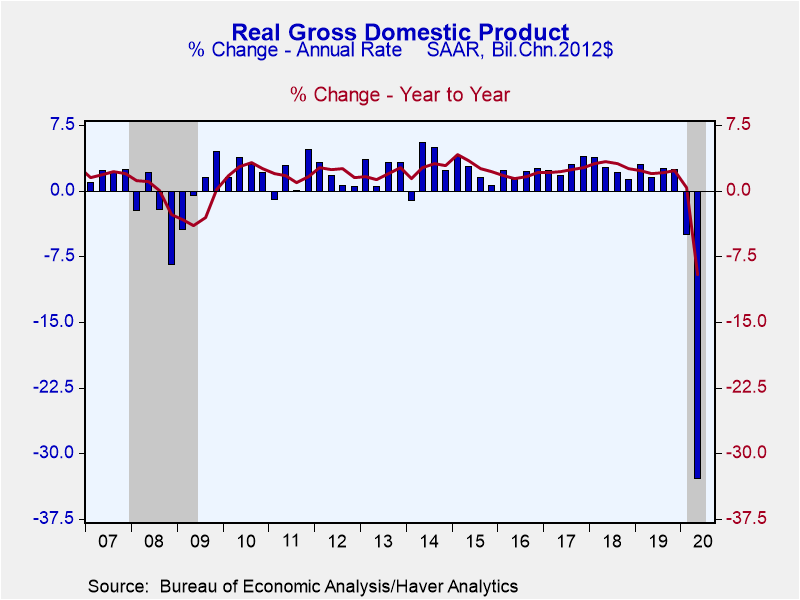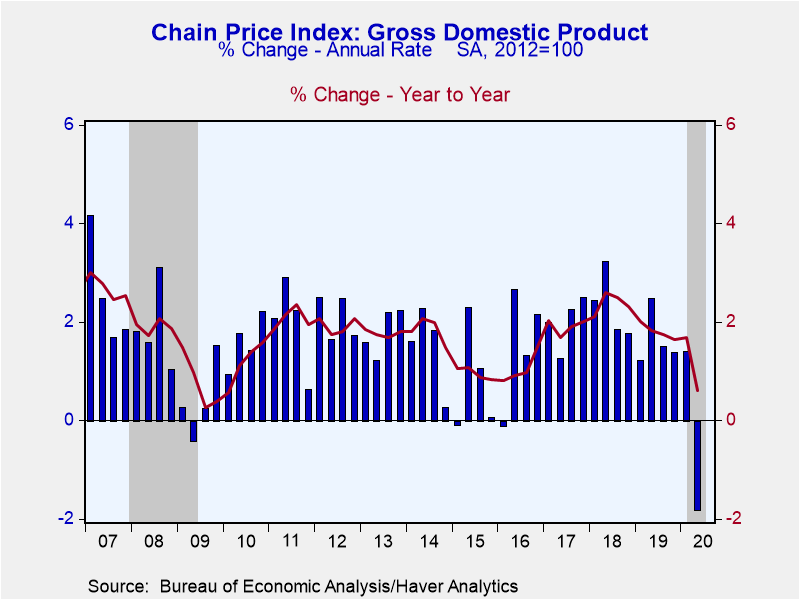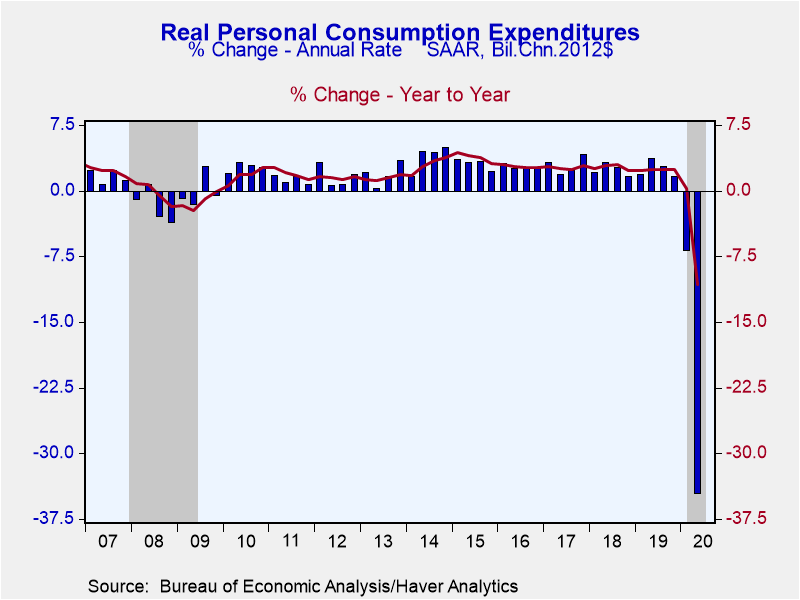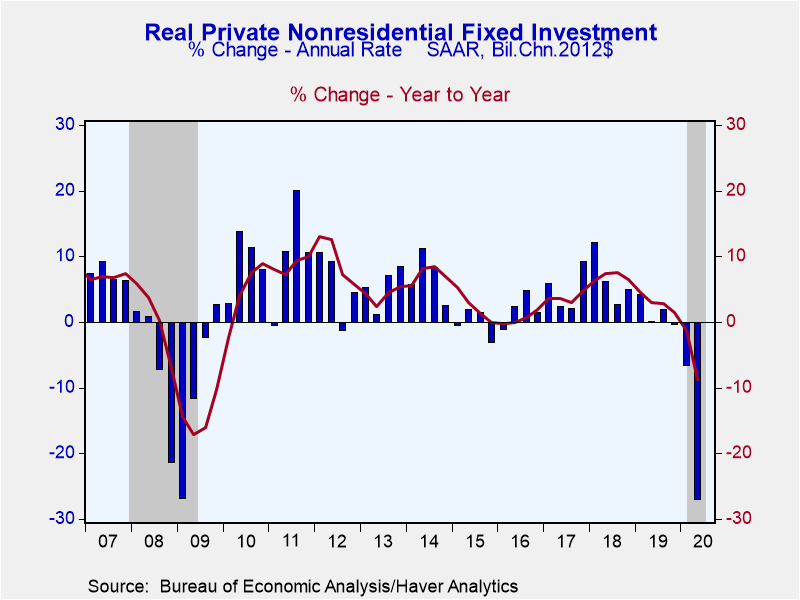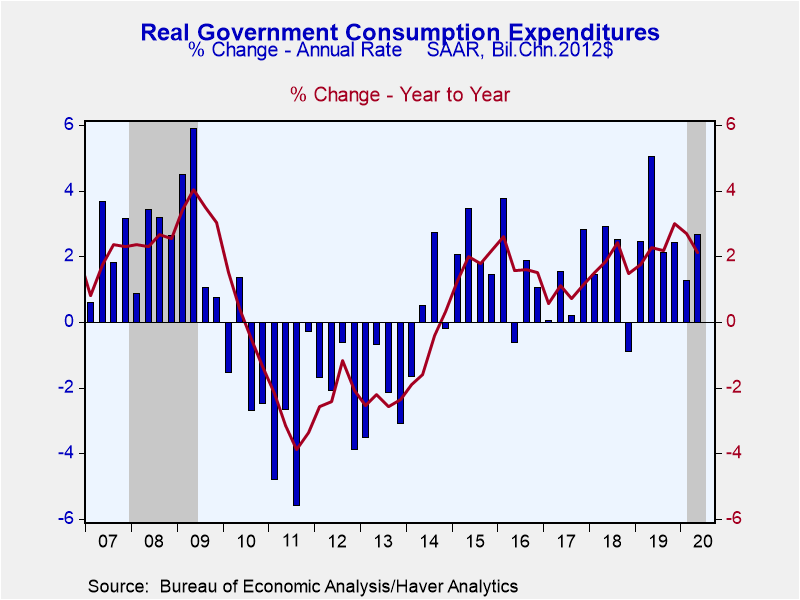 Global| Jul 30 2020
Global| Jul 30 2020U.S. GDP Records Steepest Decline Since WWII
by:Tom Moeller
|in:Economy in Brief
Summary
• Coronavirus shuts down consumption & investment • Housing declines sharply but government spending increases. • Price inflation turns negative. U.S. GDP declined 32.9% (AR) during Q2 2020 following an unrevised 5.0% Q1 fall. The [...]
• Coronavirus shuts down consumption & investment
• Housing declines sharply but government spending increases.
• Price inflation turns negative.
U.S. GDP declined 32.9% (AR) during Q2 2020 following an unrevised 5.0% Q1 fall. The decline was the steepest of the postwar period. It contrasted with a 35.0% decline expected in the Action Economics Forecast Survey.
Domestic final sales fell 28.2% after a 4.6% drop. Consumer spending weakened 34.6% (-10.7% y/y). It sapped 25.1 percentage points from GDP growth. Services outlays fell 43.5% (-14.7% y/y) following a 9.8% decline. Outlays on recreation collapsed 93.5% (-54.1% y/y) while spending on transportation declined 83.9% (-40.2% y/y). Outlays at hotels & restaurants were off 81.2% (-39.7% y/y) and health care spending fell 62.7% (-24.2% y/y). Offsetting these declines was a 4.6% gain (1.5% y/y) in spending on housing & utilities and a 1.1% rise (1.2% y/y) in financial services & insurance outlays. Spending on durable goods eased 1.4% both q/q and y/y. Motor vehicle outlays rose 5.5% (-6.0% y/y) following a 28.5% drop. Spending on home furnishings & appliances declined 10.6% (-1.8% y/y) but recreation goods & vehicles rose 40.5% (15.3% y/y). Spending on nondurable goods weakened 15.9% (-2.0% y/y) as clothing outlays were off 48.4% (-23.1% y/y). Gasoline & fuel oil outlays weakened 54.7% (-22.6% y/y) as stay-at-home lockdowns continued. Food & beverage buying eased 6.4% (+6.0% y/y) after rising 30.9% in Q1.
Business fixed investment fell 27.0% (-8.8% y/y), the largest of three consecutive quarterly declines. Investment in structures was off 34.9% (-11.5% y/y) and equipment spending fell 37.7% (-15.5% y/y). Industrial equipment investment weakened 22.5% (-9.3% y/y) but investment in information processing equipment rose 22.3% (1.1% y/y). Transportation equipment investment declined 85.7% (-44.1% y/y) and intellectual property outlays weakened 7.2% (+1.2% y/y).
Residential investment fell 38.7% (-5.2% y/y) and reversed three consecutive quarters of positive growth.
Government spending rose 2.7% (2.1% y/y), powered by a 39.7% jump (10.9% y/y) in nondefense spending. It reflected tax rebate checks sent to most individuals which lifted federal government nondefense spending on consumption by 58.0% (13.5% y/y). Defense outlays improved 4.1% (4.0% y/y). Spending by state & local governments declined 5.6% (-0.7% y/y).
Inventory liquidation subtracted 4.0 percentage points from GDP growth last quarter. That was partially offset by improvement in the foreign trade balance which added 0.7 percentage points to growth. Exports declined 64.1% (-23.7% y/y) while imports were off 53.4% (-22.1% y/y).
The GDP price index declined a near-record 1.8% (+0.6% y/y). A 0.1% rise had been expected. The PCE price index worked 1.9% lower (+0.6% y/y) as prices less food & energy prices fell 1.1% (+0.9% y/y). The business fixed investment price index increased 0.7% (0.4% y/y) as the price index for computers & software rose 3.0% (0.7% y/y). The equipment price index eased 0.3% (-0.2% y/y). The residential price index rose 1.1% (2.2% y/y) while the government sector price index fell 2.1% (+0.6% y/y).
The GDP figures can be found in Haver's USECON and USNA database. USNA contains virtually all of the Bureau of Economic Analysis' detail in the national accounts. Both databases include tables of the newly published not seasonally adjusted data. The Action Economics consensus estimates can be found in AS1REPNA.
| Chained 2012 $ (%, AR) | Q2'20 (Advance Estimate) | Q1'20 | Q4'19 | Q2'20 Y/Y | 2019 | 2018 | 2017 |
|---|---|---|---|---|---|---|---|
| Gross Domestic Product | -32.9 | -5.0 | 2.4 | -9.5 | 2.2 | 3.0 | 2.3 |
| Inventory Effect (%-point) | -4.0 | -1.3 | -0.8 | -1.7 | 0.0 | 0.2 | -0.1 |
| Final Sales | -29.3 | -3.6 | 3.2 | -7.8 | 2.2 | 2.8 | 2.4 |
| Foreign Trade Effect (%-point) | 0.7 | 1.1 | 1.5 | 0.3 | -0.1 | -0.2 | -0.1 |
| Domestic Final Sales | -28.2 | -4.6 | 1.6 | -8.1 | 2.3 | 3.0 | 2.5 |
| Demand Components | |||||||
| Personal Consumption Expenditure | -34.6 | -6.9 | 1.6 | -10.7 | 2.4 | 2.7 | 2t.6 |
| Nonresidential Fixed Investment | -27.0 | -6.7 | -0.3 | -8.8 | 2.0 | 6.9 | 3.7 |
| Residential Investment | -38.7 | 19.0 | 5.8 | -5.2 | -1.7 | -0.6 | 4.0 |
| Government Spending | 2.7 | 1.3 | 2.4 | 2.1 | 2.3 | 1.8 | 0.9 |
| Chain-Type Price Index | |||||||
| GDP | -1.8 | 1.4 | 1.4 | 0.6 | 1.8 | 2.4 | 1.9 |
| Personal Consumption Expenditure | -1.9 | 1.3 | 1.5 | 0.6 | 1.5 | 2.1 | 1.8 |
| Less Food & Energy | -1.1 | 1.6 | 1.3 | 0.9 | 1.7 | 2.0 | 1.7 |
| Nonresidential Investment | 0.7 | 1.0 | -0.4 | 0.4 | 1.3 | 0.9 | 0.9 |
| Residential Investment | 1.1 | 2.3 | 2.4 | 2.2 | 2.8 | 5.6 | 4.5 |
Tom Moeller
AuthorMore in Author Profile »Prior to joining Haver Analytics in 2000, Mr. Moeller worked as the Economist at Chancellor Capital Management from 1985 to 1999. There, he developed comprehensive economic forecasts and interpreted economic data for equity and fixed income portfolio managers. Also at Chancellor, Mr. Moeller worked as an equity analyst and was responsible for researching and rating companies in the economically sensitive automobile and housing industries for investment in Chancellor’s equity portfolio. Prior to joining Chancellor, Mr. Moeller was an Economist at Citibank from 1979 to 1984. He also analyzed pricing behavior in the metals industry for the Council on Wage and Price Stability in Washington, D.C. In 1999, Mr. Moeller received the award for most accurate forecast from the Forecasters' Club of New York. From 1990 to 1992 he was President of the New York Association for Business Economists. Mr. Moeller earned an M.B.A. in Finance from Fordham University, where he graduated in 1987. He holds a Bachelor of Arts in Economics from George Washington University.


